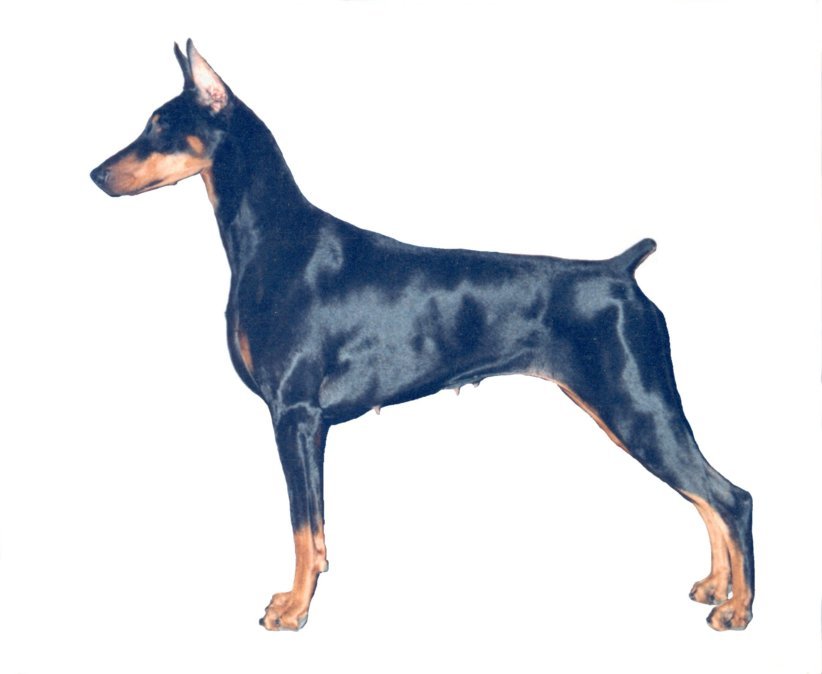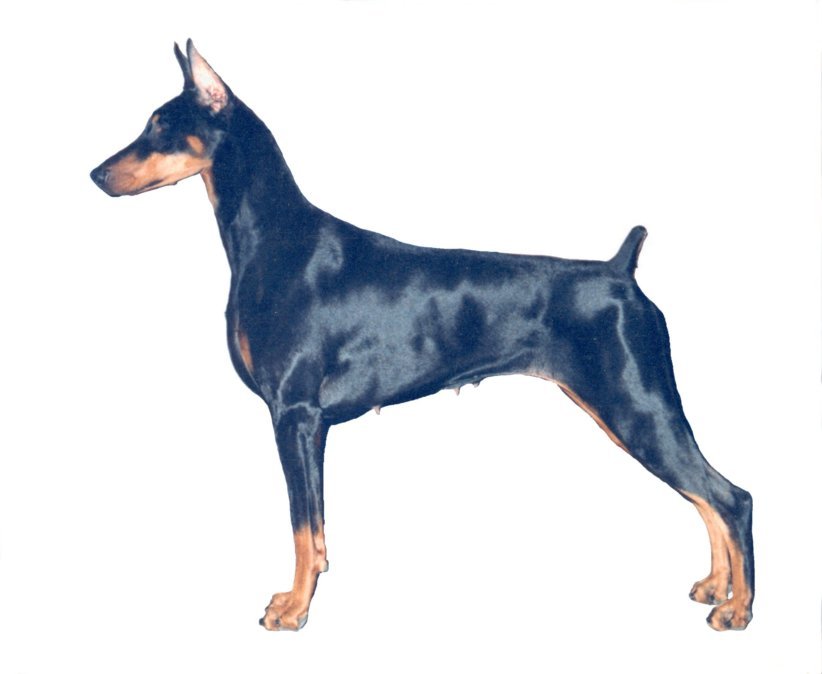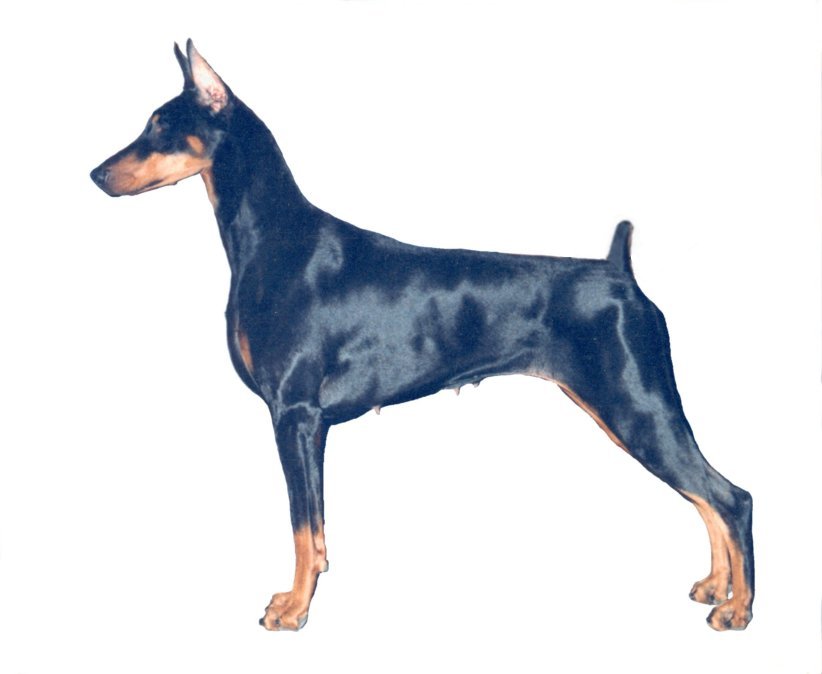Neck proudly carried, well muscled and dry. Well arched, with nape of neck widening gradually toward body. Length of neck proportioned to body and head. Withers pronounced and forming the highest point of the body. Back short, firm, of sufficient width, and muscular at the loins, extending in a straight line from withers to the slightly rounded croup.
Chest broad with forechest well defined. Ribs well sprung from the spine, but flattened in lower end to permit elbow clearance. Brisket reaching deep to the elbow. Belly well tucked up, extending in a curved line from the brisket. Loins wide and muscled. Hips broad and in proportion to body, breadth of hips being approximately equal to breadth of body at rib cage and shoulders.
Tail docked at approximately second joint, appears to be a continuation of the spine, and is carried only slightly above the horizontal when the dog is alert.
Neck proudly carried, well muscled and dry – The neck is proportional in length and width to the head and body, tapering gently from the body to the head. It appears almost as wide as the body at the body, tapering gracefully but powerfully to the head. The muscle that runs from behind the ear, down the neck, down the front and attaches itself around the upper arm, helps pull the upper arm forward while the dog is gaiting, thus assisting in the reach of the dog. Again, the length of the neck should be in proportion to the body and head. A short neck reduces reach and a neck that is too long stretches the muscle making it weaker, so the dog has to struggle more for efficient gaiting and balance. The neck should widen gradually toward the body- it should not be “skinny” or “thick” and have a natural arch (not the one the handler molds into the dog). The withers form the highest point of the body. All measurements are proportional to the height at the withers; all parts are in proportion to the body.
Back is short, firm – If the back is too short, the dog is out of balance and can’t move out of it’s own way, and usually compensates by over-striding or over-reaching. These dogs compensate in several ways; some may have longer, more sweeping stifles like a German Shepherd or Weimaraner, and some may have straighter stifles with long hocks. If the back is too long, the entire topline can sag or bounce when the dog moves. The problem with the requirement of a square body with a short back, plus the additional 90 degree angulation at each end of the dog, is that there is no way the dog can get out of it’s own way unless it’s in complete balance!
Back of sufficient width, and muscular at the loins, extending in a straight line from withers to the slightly rounded croup– when looking down on the dog, there should be an “hour glass” shape and not a “tube”. The shoulders, ribs, and the rear should be the same width. The slightly rounded croup may not look as pleasing as the flat croup, but it is correct. In this case the “back” is referring to the topline and should be in a straight line from the withers to the correct croup. This straight line is based on a correctly built dog and will be `level’ rather than `sloping’ if the dog has correct structure. The dramatically sloping topline is a clear indication that proper balance is not present because the angles at each end don’t match. The dog with a level to slightly sloping topline has correct balance. The correct topline fits a dog whose legs are under him, ready to move in any direction. The dog’s major weight is balanced on his front feet, rear legs squarely set, ready to move forward or to the side. The extremely sloping topline fits a dog standing, but not ready for movement. The topline will slope if the shoulders are straighter or if the dog has too much turn of stifle, which will lower the rear.
Chest is broad with the forechest well defined – meaning that the forechest has “definite and distinct lines or features,” not necessarily well endowed! The original 1923 standard stated “chest arched and reaching deep to the elbow.” Moderation is another key to a Doberman. A Doberman is not supposed to have excessive forechest, but enough to indicates there is a forechest; showing the precise outline of it. A large forechest doesn’t necessarily mean a good front.
Brisket reaching deep to the elbow – The depth is important because a larger body cavity allows more room for the organs. The underline is formed by the 1) deep brisket which flows back through 2) the ribs that extend far back in the body that gradually shorten to form 3) the tuck up flowing into the short loin. These are all important to a correct body and the impression of power and endurance. Underlines can have as many problems as toplines! Belly well tucked up does not mean a wasp waist or herring gut. The tuck up can be too extreme or the reverse of no, or too little tuck up giving the dog a `flat’ underline that appears straight across. The underline should gradually angle up to allow the hindquarters to reach under the dog comfortably while the dog is gaiting.
Loins wide and muscled, but not as wide as the rear. The rear should not be narrow, but broad and well muscled, it should be the same width as the ribs- assuming the dog is not slab sided.
Tail docked at approximately the 2nd joint, appears to be a continuation of the spine and is carried only slightly above the horizontal when the dog is alert – tail length varies from one to three joints. One joint appears very short, while three can be quite long. The correct tail appears to be a continuation of the spine and is carried just above horizontal (when the dog is alert). The tail carriage is out, rather than up. Thus if you were looking at a clock, 3 o’clock is obviously horizontal, the correct tail placement is around 2 o’clock, much lower carriage than usually seen. A higher tail does not look like a continuation of the spine and generally indicates a flat, rather than slightly rounded croup. This may be pleasing to the eye, but it INCORRECT structure! If you had the same degree of `incorrectness’ in the front, it would be like saying you like a straight shoulder — that a straight shoulder is pleasing!
Tail carriage (slightly above the horizontal when the dog is alert) (3 o’clock is horizontal)
At 2 o’clock
|
At 1 o’clock
|
At 12 o’clock
|
|
|
|
Click the following links to read more articles in the “Dobermans in Detail” series:
by Linka Krukar submitted by Marj Brooks


